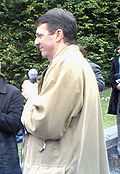Politics of Liguria
 |
| This article is part of a series on the politics and government of Liguria |
|
|
Politics portal |
The Politics of Liguria, Italy takes place in a framework of a presidential representative democracy, whereby the President of Regional Government is the head of government, and of a pluriform multi-party system. Executive power is exercised by the Regional Government. Legislative power is vested in both the government and the Regional Council.
Executive
The Regional Government (Giunta Regionale) is presided by the President of the Region (Presidente della Regione), who is elected for a five-year term, and is composed by the President and the Ministers (Assessori), who are currently 11, including a Vice President.[1]
List of Presidents
 |
| This article is part of a series on the politics and government of Liguria |
|
|
Politics portal |
This is the list of Presidents of Liguria since 1970.
President of Liguria (1970-present)
| President | Took office | Left office | Party | ||
|---|---|---|---|---|---|
| 1 |  |
Gianni Dagnino | 1970 | 1975 | Christian Democracy |
| 2 |  |
Angelo Carrosino | 1975 | 1980 | Italian Communist Party |
| 3 |  |
Giovanni Persico | 1980 | 1981 | Italian Republican Party |
| 4 |  |
Alberto Teardo | 1981 | 1983 | Italian Socialist Party |
| 5 |  |
Rinaldo Magnani | 1983 | 1990 | Italian Socialist Party |
| 6 |  |
Giacomo Gualco | 1990 | 1995 | Christian Democracy |
| 7 |  |
Giancarlo Mori | 1995 | 2000 | Italian People's Party |
| 8 |  |
Sandro Biasotti | 2000 | 2005 | Forza Italia |
| 9 |  |
Claudio Burlando | 2005 | Incumbent | Democrats of the Left then Democratic Party |
| ||||||
Legislative branch
The Regional Council of Liguria (Consiglio Regionale della Liguria) is composed of 40 members. 32 councillors are elected in provincial constituencies by proportional representation using the largest remainder method with a Droop quota and open lists, while 8 councillors (elected in bloc) come from a "regional list", including the President-elect. One seat is reserved for the candidate who comes second. If a coalition wins more than 50% of the total seats in the Council with PR, only 4 candidates from the regional list will be chosen and the number of those elected in provincial constituencies will be 36. If the winning coalition receives less than 40% of votes special seats are added to the Council to ensure a large majority for the President's coalition.[2]
The Council is elected for a five-year term, but, if the President suffers a vote of no confidence, resigns or dies, under the simul stabunt, simul cadent prevision introduced in 1999 (literally they will stand together or they will fall together), also the Council is dissolved and a snap election is called.[3]
Parties and elections
Latest regional election
In the latest regional election, which took place on 28–29 March 2010, Claudio Burlando (Democratic Party) defeated Sandro Biasotti (The People of Freedom).
| Candidates & parties | votes | votes (%) | seats reg. list |
seats prov. lists |
|---|---|---|---|---|
| Claudio Burlando | 424,044 | 52.15 | 8 | 17 |
| Democratic Party | 211,500 | 28.35 | → | 10 |
| Italy of Values | 63,028 | 8.45 | → | 3 |
| Union of the Centre | 29,335 | 3.93 | → | 1 |
| Federation of the Left | 29,148 | 3.91 | → | 1 |
| We with Burlando | 27,607 | 3.70 | → | 1 |
| Left Ecology Freedom | 18,418 | 2.47 | → | 1 |
| Federation of the Greens | 8,624 | 1.16 | → | 1 |
| Bertone List | 5,723 | 0.77 | → | - |
| Sandro Biasotti | 389,132 | 47.85 | 1 | 14 |
| The People of Freedom | 218,398 | 29.27 | → | 10 |
| Lega Nord Liguria | 76,265 | 10.22 | → | 3 |
| Biasotti President | 45,261 | 6.07 | → | 1 |
| People of Italy | 5,398 | 0.72 | → | - |
| The Right | 2,688 | 0.36 | → | - |
| Pensioners' Party | 2,566 | 0.34 | → | - |
| New PSI | 2,076 | 0.28 | → | - |
| Total | 813,176 | 100.00 | 9 | 31 |
Source: Ministry of the Interior – Historical Archive of Elections